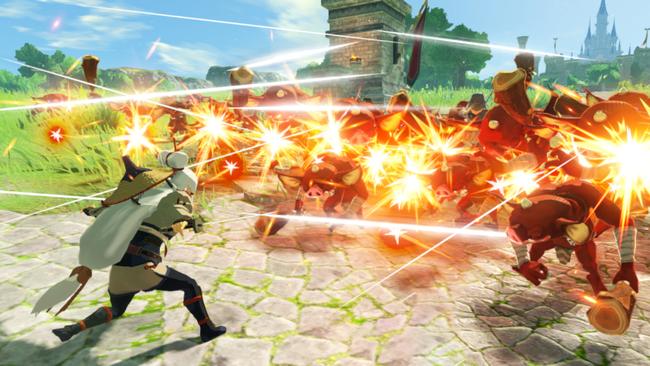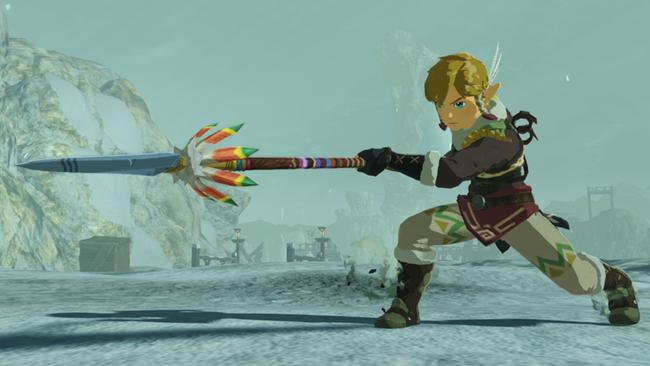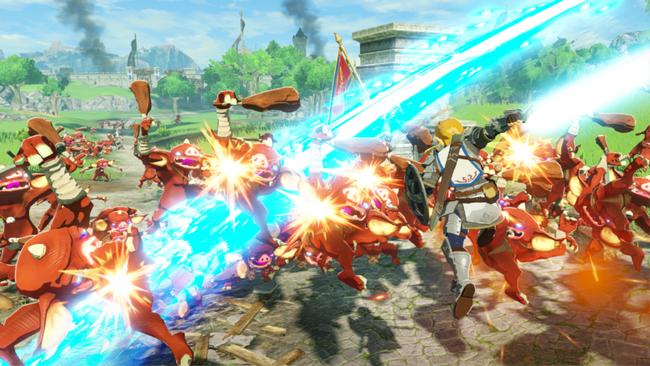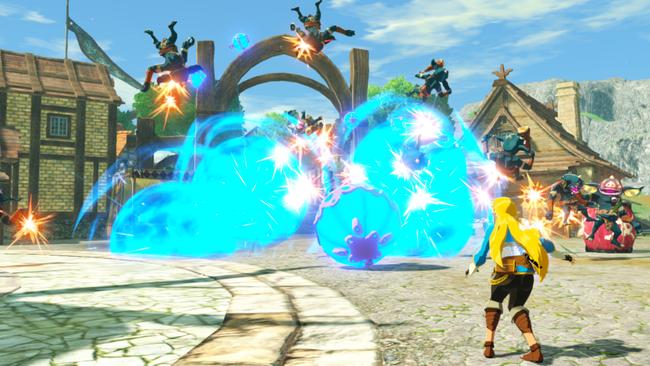
Hyrule Warriors: Age of Calamity Review
Hyrule Warriors, the 2014 Dynasty Warriors styled spinoff of The Legend of Zelda, was a great game that I didn’t like. I tried playing each revision that released, and none of them ever managed to resonate with me. Each time, I found myself dropping the game early on, which is weird because I tend to enjoy Musou games. Just because I didn’t care for it, doesn’t mean that it’s poorly designed or lacking in content. These kinds of games are often mindless fun, and while not every cross-over game Koei Tecmo develops in the genre is a winner, I get excited every time one comes out.
So when I heard that not only was the Hyrule Warriors formula getting another chance, but it was also a prequel to Breath of the Wild, I was pretty stoked. I love Breath of the Wild, it’s still my favorite Zelda game to date. It might sound arbitrary, but an engaging story with a cast of characters I already enjoy was all this game needed to win me over.

But Age of Calamity is set a hundred years before the events of Breath of the Wild. If one was to assume that this was a story that never needed to be told, they would be right, and the writers would agree with you. I won’t go into detail on how it diverges from expectations, but it does so immediately and I feel successfully sets things up to play out a bit differently than what the audience might expect. I’m one of the few people who adored just about everything to do with the story of Breath of the Wild, especially how it used a minimalist style exposition that worked well with the gameplay. The changes made to past events not only make for an entertaining story, but benefits the Dynasty Warrior formula. If you haven’t played it, that might not make the most sense, but I was completely sold on this approach with a middle-game reveal.
There is a considerable increase in the number of cutscenes, and thankfully I think the returning characters still retain what made them special. This iteration of Zelda continues to be one of the strongest in the franchise, and this game highlights her conflicted relationship with her destiny further by fleshing out her character more. In fact, I’d say all the characters are skillfully fleshed out here, and the new cast fits in better than I expected as well. Many of them seem very Musou Villain, but they work. Link is also given more characterization, which plays off of the minor visual touches in his animations from the original game.
Breath of the Wild’s open-world survival mechanics have been adapted to the Dynasty Warriors gameplay style surprisingly well. It’s still a Dynasty Warriors game though and certainly plays just like how you’d expect. There isn’t free roam exploration, but some of the most memorable locations of the original game have turned into combat playgrounds where you hack and slash armies of enemies. Every character has a unique moveset, and you can choose up to four of them in your party for a mission. You can issue orders to your team, which is essential because the NPCs couldn’t fight themselves out of a paper bag without your input. When you aren’t in control of one of your party members, they’ll essentially stand around and do nothing. This requires you to take charge and keeps you in the action, but I think an AI upgrade is overdue. This is to be expected from these games, so I don’t think it’s too much of a flaw, but it leads to missions feeling like they could get unfair while playing on the Hard Difficulty.

Link isn’t just a regular sword and shield user like in Hyrule Warriors; this time he’s the ultimate jack-of-all-trades. He’s able to wield spears and two-handed weapons in addition to his familiar style. Each of these plays completely different from the others, making Link essentially three different characters in one. Breath of the Wild inspires the changes to his character from the original Hyrule Warriors, but also seems to expand his sword and shield style slightly.
The more surface level improvements come with the change in aesthetic over the first Hyrule Warriors. I don’t know if this actually repurposing the Breath of the Wild engine or using a Koei Tecmo engine, but based on their past works I’m going to assume the latter is true. This might be one of the best attempts I’ve seen from them to adapt a pre-existing property’s visual identity. The fact that it’s hard for me to tell, thanks to some stunning in-engine cutscenes that seem right out of Breath of the Wild (I’ve said that name so many times, but it’s pretty unavoidable), is impressive in its own right. Most of the time during my 29-hour playthrough, this adventure felt right at home in the world Nintendo created for their latest mainline Zelda. Trees can be destroyed for wood, monsters drop familiar parts that can be used to cook, Runes and elemental rods are vital combat items, and there’s a large array of collectible weapons. Dropping weapon durability, Age of Calamity introduces an RPG progression system with your weapons. Fusing them together will increase their level, which improves damage output and can give them certain perks. I loved the durability system, but this is a great change for the musou formula.
However, recreating Breath of the Wild’s aesthetic so faithfully had some downsides in terms of performance. Instead of aiming for a smooth 60 fps like Hyrule Warriors: Definitive Edition does on the same platform, Age of Calamity aims for 30 fps on both docked and undocked. Just like how Definitive Edition fails to accurately hit its targeted framerate, this game does the same. I don’t necessarily think the drop to 30 was a bad thing, even if I prefer my action games to run as well as possible, but I wish they had aimed to keep the experience a consistent 30. I’m not Digital Foundry, but even I can tell the performance is this messy. It feels like every time there is serious action on screen, the game dips to around 20 fps -which, in a musou game is kinda all the time. I somehow got used to this inconsistent framerate, but it did happen frequently enough to detract from my overall experience. In addition to this, the resolution isn’t as high as Breath of the Wild’s, but is still crisp enough to appreciate the visuals. The only part of the visuals that really stood out as bad was some unfortunate environmental pop-in, mainly anything that can be destroyed, due to a below-average draw distance.

Despite my issues with the performance though, I can’t help but feel like it didn’t hamper my overall enjoyment with the combat. Link isn’t the only character that plays great, and I’d argue that every single member of the cast stands out as unique. While not pulling from a large list of popular characters across the franchise’s most popular entries, Age of Calamity surprised me with the variety and number of playable characters. Each character has a special attack that uses a meter gained by mowing down enemies, but what makes them truly stand out is their unique action with the ZR button. For link this shoots arrows, for Revali it makes him fly, and it goes on from there. No two characters play the same, and the list of unlockable characters felt impressively creative. It doesn’t aim for the massive roster, but instead a modest one with movesets that continue to grow and improve even after the credits wrap.
A musou game is nothing without an exciting soundtrack, which is the one part I was frankly worried about since Breath of the Wild prided itself in its minimalistic approach to music. What I heard of Hyrule Warriors OST was slightly lacking and felt a bit generic, and I’m impressed with the direction they took Age of Calamity. The composer took the style of music frequently seen in Breath of the Wild’s memory segments and applied that to the whole game. It works really well, and there are several songs that still stand out to me after finishing it.
Where the game consistently falters is the health system, which involves collecting apples around the field. By pressing the left bumper you can pull up a menu where your Apple Meter will allow you to heal yourself. The issues come from apples being incredibly scarce, and this feels like an oversight, one that unfortunately affects the game’s balancing. Your apples and elemental rods carry over between missions, but that also means your lack of these items can carry over as well. To my knowledge, there is no way to purchase apples outside of battle which makes preparation rather difficult. While food can be crafted before a fight to give you certain buffs, I feel this system should have maybe been re-worked to allow you to cook some food to store and use in battle. There should have been a middle-ground reached because too many health items would make the game too easy, but as it stands now some missions can feel unfair and tedious as you scrounge for apples in maps with so few. The Gerudo desert maps and the late-game areas stick out with this problem the most in my experience.

Another aspect where I feel the game needed a bit more time in the oven were the Divine Beast missions. I’m glad these are in the game, as piloting these titans to destroy Calamity Ganon’s forces in even bigger amounts was mostly pretty fun and gave the gameplay more variety, but they don’t control the best. Aiming can feel stiff at times and highlights the underwhelming gyroscope implementation. It doesn’t feel as good as it does in Breath of the Wild, and your aiming feels a lot more limited. These were incredibly ambitious, and I think they worked more than they didn’t, but it could have been much better.
The difficulty balancing of the game is a minor issue, one that I found remedied by playing the first half of the game on hard mode and the second half on normal mode. While the early game hard mode kept my attention by making it feel more like a thoughtful action game, in comparison to normal mode that is far too easy in the beginning, The Divine Beast missions were what made me turn it down to normal and keep it that way. They don’t feel designed around the harder difficulty, with enemies dealing ridiculous amounts of damage that feels unfair for your slow machines to properly deal with. Thankfully normal mode becomes actually challenging after a while and gave me a sense of earned satisfaction from clearing missions that most games in this genre just can’t do.
As you progress through the story, the gameplay loop starts to become apparent. Populated on each battlefield are regular enemies and stronger mini-boss like enemies. The second type can be targeted, revealing a large health bar so mashing will not work. This is where I feel the game gets repetitive, and those who are not used to this flow of a musou game might not like how most of these engagements boil down to the same thing. Normal attacks will chip away at their health, but if you want to take them down efficiently you need to stagger them. This can be done by hitting them when they’re vulnerable or by using any elemental rod you obtain from downed wizrobes.
However, given one important change inspired by Breath of the Wild, this repetition becomes fun. Parries (if a character has a Shield) will stun enemies and perfect dodging activates flurry rushing. This will chip away their stagger meter fast, making it feel like the player has more agency in taking down enemies. There are other ways to knock down more stagger meter without having to wait for them to attack, encouraging players to stay on the offensive. Link’s bow action is perfect for this, and enemies will falter with a well-aimed shot to the head/eye. Enemies will also have tells in the form of Rune icons, requiring you to quickly use the respective Rune with the right bumper to intercept them. Most of the time this worked, but regularly I would notice this would miss and would lose a decent chunk of my health. I think while this sounds very negative, this repetition works in the game’s favor. Not all repetition is bad, despite the negative connotation associated with the term. It becomes comfortable, while never getting too comfortable to get boring. I loved the combat in this game despite the faults, I genuinely couldn’t put the game down.

The addictive nature of the game is also thanks to how the game frames its mission structure with the world map. Those upset that this lacks the adventure mode of Hyrule Warriors shouldn’t worry, there is frankly an insane amount of content in this game. As of the time of writing this, I have finished the main story and only have cleared 47% of the game’s content. Age of Calamity is huge. The opening hours will trickle side missions and quests throughout to ease you into it, but it doesn’t take long for your map to be full of them. It’s overwhelming in the best possible way, and the reason this review took so long is that I got so distracted by side content that I just avoided playing the last mission. I’d recommend not trying to clear every mission as it unlocks and just taking them at your own pace, and I found the post-game serves as a great time to strive for 100% completion.
You feel like you’re not only rebuilding Hyrule, but also improving your army with every mission cleared. You can unlock clothes for Link, shops, an armory, and can improve your characters. Every character will have several objectives placed on the map that will require you to gather materials to improve their stats in a noticeable way. Sometimes this is by giving them more health or special bars, but this is also how you unlock more of their combo strings. This might be the best character progression system I’ve played in a musou game because it encouraged me to engage with the game as much as possible. While free roam exploring did not make it into this game, I felt like the sense of exploration was refocused to othergameplay systems. Helping the residents of Hyrule improves how much you enjoy the combat. There’s so much to see and discover in this game, and I appreciate that Koei kept this focus on secrets from Breath of the Wild. There are still new aspects of the game mechanics I’m still learning about after the credits roll that further increase your options.
Hyrule Warriors: Age of Calamity isn’t revolutionary, but I can’t deny that the Breath of the Wild touches to the formula leads it to be one of the better musou games on the Switch. Writing this review has been a bit challenging, because a good musou game is pretty self-explanatory. Most of the time, it even tends to be a great one with a staggeringly large amount of content. Outside of performance issues, the design is overall very tight and enjoyable, but the cast of characters and the gameplay truly shine for this genre. I’m hoping that the rumored Switch Pro is real, because I’d love to see how this looks and runs with better hardware. If you enjoyed Breath of the Wild’s story and characters, and like musou games, this is a great combination of the two that’s worth checking out.